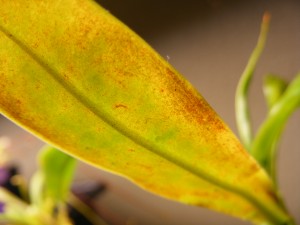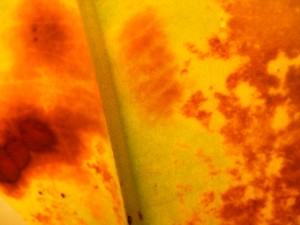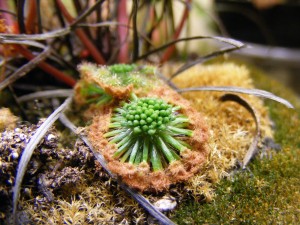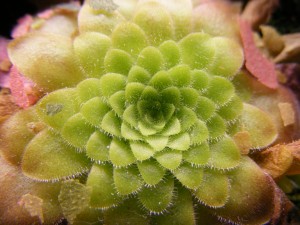If you have any other questions regarding the health of your plants, feel free to fill out the contact form under the Contact page or email us at info@gemstatecarnivores.com.
Looking for general plant care information? Visit the How do I take care of my plant? page.
Most carnivorous plant problems are one of three things:
- Not enough light
- Most carnivorous plant will lose their coloration and turn green when provided with less than adequate lighting. Sundews will often lose their “dew” and may become somewhat lanky. Venus flytraps tend to become dark green, produce small traps, and the petioles (the part below the trap) become wide and flattened against the soil. Tropical pitcher plants often will reduce pitcher production under inadequate lightening.
- Move your plants to a brighter window location or place 6 to 12 inches under artificial light. Improvements (resumption of growth, “dewiness” on sundews, return of bright colors) should be seen within a few weeks.
- Not enough water
- Keep the soil moist at all times!
- Fill your plant tray with up to 1 inch of water and let the water completely evaporate, then refill.
- Insect diseases
- While carnivorous plants can eat most bugs, a select few can cause problems for the plant’s health. The most common damaging insects are aphids, thrips, and spider mites. Look for indicators such as small white insect shells, deformed or damaged new leaves, and fine webs covering leaf surfaces. Luckily, these bad insects can be removed with an application of insecticides. Home improvement stores have a variety of easy to use spray bottle insecticides. Remember to read the label carefully and apply as directed
- If the insects are removed, your plant’s appearance should resume to a normal state.
However, some plant issues are more specific to certain kinds of carnivorous plants:
Venus Fly Traps (Dionaea)
Why isn’t my plant robust and colorful?
- Some cultivars simply stay green or only color sparingly.
- Low light intensities or a short duration of light exposure may cause your plant to have wide petioles (the flat leaf like portion before the trap) and to have a dark green color. Give your plant more light if this happens.
- Check carefully for aphids, spider mites, or red mites. Outdoor plants may be exposed to these pests. Home improvement stores have a variety of easy to use spray bottle insecticides. Remember to read the label carefully and apply as directed.
Why do my leaves look burnt?
- When converting an indoor venus fly trap to an outdoor plant, burning of the leaves may occur due to light intensities that the plant is not accustomed to.
- Move the plant to a shadier region and slowly allow it to become adjusted to brighter light.
Tropical Pitcher Plants (Nepenthes)
Are leaves or pitchers dieing?
- Pitchers commonly will die when placed into a new environment. Do not worry, the plant will naturally adapt to the conditions of its new home and normal growth will commence.
- Pitchers and leaves naturally senesce and die as the plant grows. An old leaf may look like the following picture (yellowing and then turning black):

- If the tendrils (the thin section leading to the pitcher) leading to undeveloped pitchers are dry and withered, your plant may require more water or more consistent watering or more light.
- If the leaves look withered and dry, keep the soil moister.
- However, blackening of the growth tip (the newest growth that appears as a short immature folded leaf) may indicate overwatering or the plant is succumbing to stress. Rarely does this happen to a healthy plant.
Why isn’t my plant making pitchers?
- Give your plant lots of time to adapt to its new home.
- Ensure the soil is moist.
- If the soil is moist, insufficient light intensity is likely the cause. Bring your plant to a brighter space or expose it to bright light for a longer time period.
Why are my plant’s leaves curling?
- Typically this is due to water stress. As the plant loses water in its cells, the leaves curl in response. Keep the soil moist with more consistent watering.
- In some instances, spider mites, red mites, thripts or aphids may cause this.
- The following image shows a plant that is suffering from red mites. Notice the unusual curling and short stunted leaves. Any plants suffering from insects will have insects present, therefore, a magnifying glass may be needed to see them.

- If you visually confirm the presence of harmful insects, carefully wipe the leaves with a diluted soap solution and then apply an insecticide. Home improvement stores have a variety of easy to use spray bottle insecticides. Remember to read the label carefully and apply as directed.
- Lowland pitcher plants often require higher humidity. Any lowland pitcher plants for sale will be indicated as needing higher humidity. Either use a clear plastic bag or a terrarium to raise the humidity.
Why are my leaves looking burned?
- This picture illustrates a plant leaf that is receiving too much light or too much light for too long a period.
- Reduce intensity or duration of light.
Sundews (Drosera)
Why isn’t there dew on my sundew?
- A lack of dew on the tentacles is usually from a lack of either water or light. If the soil is consistently damp, increase the light intensity or the period of light exposure.
- Certain species require higher humidity levels to become dewy, such as D. adelae. Place a clear plastic bag over your plant with a small slit for air movement. An alternative is to use a terrarium.
What is the black stuff on the center of my rosette sundew?
- Sometimes too much water will cause a black residue to appear on the center of a rosette sundew. This is particularly common on rosetted South African sundews such as Drosera aliciae. Keep the water in your tray barely filled until the problem clears up or reduce the frequency of waterings.
Why does my pygmy sundew look weird?
- If your sundew looks like this, it’s perfectly natural. Pygmy sundews often produce seasonal gemmae (small vegetative reproductive bodies); essentially, mini sundews that make more sundews. Each gemmae is spring loaded to a hair at the center of the rosette. When the gemmae is dislodged, the hair flings the gemmae into the air. Simply use a finger or pencil to gently remove the gemmae. Sprinkle the gemmae around the pot and you’ll have more sundews! Normal growth should resume after gemmae are removed. Gemmae are ready to be removed when they easily fall off the plant.
North American Pitcher Plants (Sarracenia)
Why are there flat, unexpaneded pitchers growing from my plant?
- During the fall and winter or hotter parts of summer, some species or hybrids may form what are known as phyllodia (pronounced “phy-load-E-a”). Phyllodia appear as flatted, unexpanded pitchers. They are normal growth and should not be removed. Some species such as Sarracenia oreophila and it’s hybrids may make numerous phyllodia during the growing season and winter.
Why do my pitchers look deformed?
- A recently potted plant my produce deformed pitchers.
- Sometimes wind or mechanical damage of young developing pitchers may cause deformations. New pitchers should appear normal.
- Aphids sometimes attack pitchers. Home improvement stores have a variety of easy to use spray bottle insecticides. Remember to read the label carefully and apply as directed. If the aphids are removed, you can expect the new growth to look beautiful again.
How can I get rid of the fungus growing on my dormant plants?
- Remove any dead leaf tissue.
- Apply a fungicide to the dormant rhizome and the surrounding soil. Many easy to use fungicides are available at your local home improvement store. Apply fungicide as directed by the label.
Butterworts (Pinguicula)
What is happening to my butterwort’s leaves?
- Mexican butterworts have two leaf forms. These small non-carnivorous leaves are a normal part of their lifecycle. Often when plants are exposed to new conditions or lower temperatures and a reduced photoperiod, they may form these winter rosettes of small, non-carnivorous leaves. Eventually normal growth will occur.
- Often flowering will still occur when the plants are in this winter state.
Why does it look like my butterwort is splitting apart?
- Butterworts commonly divide themselves by splitting into two or more plants. Eventually, you may have a large cluster of plants!






